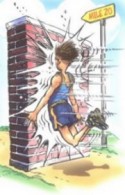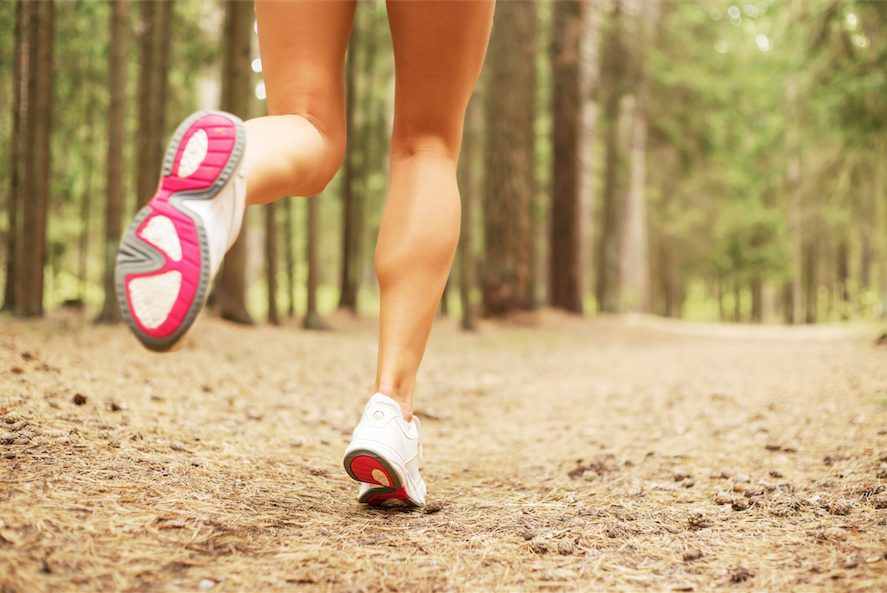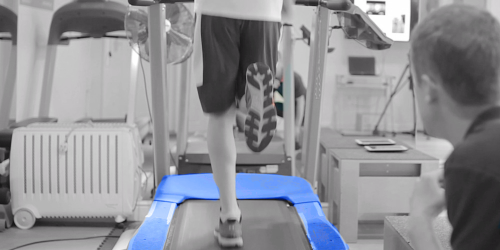THE WALL
That horrible moment when you hit ‘The wall’.
Your breathing quickly gets harder; your legs seem like lead. Every ounce of your body now screams “YOU CAN’T DO THIS” and self-doubt creeps in. You’ve hit ‘THE WALL’.
What you’re actually feeling are all the symptoms of a combination of glycogen depletion and dehydration. Run far enough and fast enough and eventually you’ll hit it. That said, there are so many ways to delay its onset or even avoid it altogether!
Keep your fuel levels topped up as you run
You should have practised taking on food during your training runs. Changing how much you eat on race day, compared to how much you’ve trained on eating, sometimes results in stomach problems, so be cautious with increasing food level on race day.
On the other hand, taking on a steady intake of carbohydrate as you run, which may not seem appealing, is actually critical – not only to help avoid hitting the wall, but also to aid boosting up the sugar levels in your blood, which directly feed those tiring muscles. As a rough guide the body can take on 1 gram of carbohydrate per kg of bodyweight per hour. For example, a 70kg runner can absorb up to 70 grams of carbohydrate in an hour.
Top Tip If using gels, check the carbohydrate levels. A 60g gel won’t be 60g of carb; often it’s more like 20g of carb.
Know what pain is okay to push through
If you’re pushing yourself then you can expect to feel muscle soreness in your legs, especially towards the end of a race, as fatigue kicks in.
Having built up your training gradually you should have a fair idea of what is a normal muscle ache for you. If the pain becomes more intense than you’re used to, or even sharp, then it’s worth considering slowing your pace and even stopping for a few minutes to stretch out. Nobody likes the idea of stopping, especially if you have a time you’re aiming for, but spending a few minutes stretching out might save you double that time if you’re then able to get back into a better running rhythm!
Avoid taking caffeinated gels all the way through your run
Studies suggest caffeine will helps boost your performance, though it can vary between individuals. In long distance races, some runners like to take a caffeine energy gel towards the end of the race when they are becoming tired. However, having caffeine too early can impede your performance as it also works as a diuretic and will start to dehydrate you. Needing a toilet break in a race is another good reason to leave it for the later stages. If using caffeine gels for something like a marathon it’s probably best to stick with standard gels until the last hour or two of your run.
Don’t psych yourself out!
This next tip is possibly the most crucial part of overcoming ‘The Wall’.
Runners often think how far they have left to go and start doubting their abilities. Mind over matter is actually the secret to long distance running. Often the body can keep fighting through, but the mind says you can’t. As you hear those doubts creeping in, it’s a case of reminding yourself ‘My mind is weak but my body is Strong’. It’s not uncommon for people to have their very own mantra they repeat to themselves as they build themselves back up from the wall. Anything that reminds you that you can do it or even why you’re doing it!
To sum it all up:
Hitting the wall does not mean the end of your run! Preparing your food intake for the run and mentally preparing yourself for what to do should you find yourself crashing into it is the best way to run through it and to the finish line!
Ruth Stubbs
Senior Physiotherapist
Synergy Physiotherapy and Sports Rehabilitation






